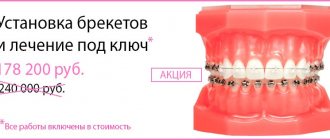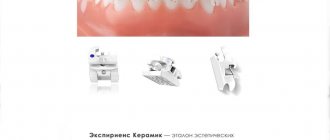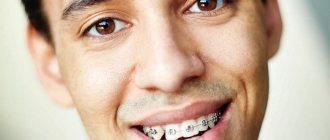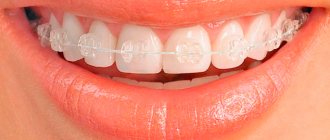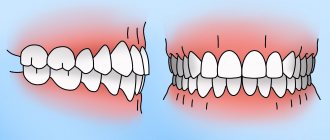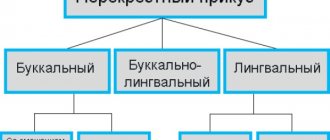From this article you will learn:
- How are braces installed?
- types of bracket systems – photos, reviews,
- how much does it cost to get braces in Moscow (for 2022).
Braces are a non-removable orthodontic structure designed to correct the incorrect position of a person’s teeth (correction of malocclusion). Braces are plates made of metal or ceramic that are glued to the outer or inner surfaces of the teeth. Each of the braces has a groove through which a metal arch with “shape memory” passes. The latter is designed to transfer forces to the teeth.
The orthodontist bends the metal arch before fixing it in braces (according to the curvature of the dentition), but under the influence of heat in the oral cavity, the arch with “shape memory” tends to return to its original “ideal” shape. As a result of the transfer of forces from the arch to the braces plates, the teeth receive the “forces” that are necessary to move them, which leads to the alignment of the dentition. The braces system for straightening teeth was first used in 1955.
Ceramic, lingual, metal braces: photos
The optimal period for installing braces for bite correction is from 8 to 14 years (at this age, the facial bones are still growing, which makes it easier for teeth to move). In addition, reviews of braces from orthodontists indicate that early initiation of treatment helps reduce the duration of treatment and facilitates the eruption of permanent teeth. As for adults, due to the cessation of growth of the facial bones, their teeth move longer than in children.
How long do you wear braces?
How long braces are worn will primarily depend on the degree of curvature of the dentition. The duration of bite correction with braces in children will be on average from 1.5 to 2 years (with minor changes in the bite - about 1 year), but in adults - on average from 2.5 to 3 years. However, the duration of treatment depends not only on the curvature of the teeth, but also on the qualifications/experience of the orthodontist, as well as on the characteristics of the brace system you choose.
For example, if you install self-ligating braces (in which the metal arch is fixed not by ligatures, but by micro-locks), the treatment will almost always last longer. This is due to the fact that self-ligating braces only have passive ligation of the metal arch and there is no ability to switch the type of ligation from active to passive, and vice versa. This means that treatment at some stage may simply stall.
In addition, when choosing self-ligating ceramic braces, the treatment will be even longer, because the archwire fixation system in the form of ceramic micro-locks on the surface of the braces is a priori less reliable. Therefore, to avoid micro-locks breaking, orthodontists usually use “less force” tactics. This means that the teeth will experience less stress, and therefore their movement will take longer. But the slowest rate of tooth movement will certainly be with lingual braces (the so-called “invisible braces”).
Important: the movement of teeth in the bone tissue of the jaws (when wearing braces) a priori cannot be a quick process. The fact is that tooth movement occurs due to the process of “bone remodeling” around the roots of the teeth being moved. This process consists of parallel resorption of bone in the direction of movement of the tooth root, and its formation behind the direction of movement of the tooth root. That is why the treatment takes a long time.
Costs for follow-up visits to the orthodontist after braces are installed
After installing braces, you need to regularly visit the orthodontist’s office to evaluate the results of treatment and correct the arch of the system, replace structural elements that are worn out or damaged. The frequency of visits will depend on the type of braces; if you choose a self-ligating system for installation, you will need to come to the clinic once every two months.
Control visits are not included in the price of installing braces and are paid separately. The cost of a planned visit to the orthodontist in our clinic depends on the set of measures that will be carried out during braces correction.
Braces: price in Moscow
For the simplest metal braces, the price in Moscow starts from 100,000 rubles for 2 jaws (in economy class and mid-price clinics). Usually the cost of braces only includes their installation and removal, i.e. the price usually does not take into account the costs of periodic correction sessions of the braces system, as well as the cost of a retainer or aligners, which will be required after the braces are removed.
A braces correction session in different clinics can cost from 1,600 to 3,000 rubles, and the lower the cost of braces, the more often correction sessions usually have to be done (for example, once a month - instead of once every 2 months). And this is not due to the orthodontist’s desire to earn more, but from the technical features of cheaper options for braces. The cost of the retainer will be approximately another 16,000 rubles. And diagnostics, which is necessary to draw up a treatment plan, will cost approximately 5,000 rubles.
The most popular models of metal braces are:
- "In-Ovation R" (Dentsply, USA),
- "Damon Q" (Ormco, USA),
- "Empower" (American Orthodontics, USA),
- "Victory" (3M Unitek, USA),
- "Forestadent" (Germany),
- "Marquis" (Ortho Technology, USA).
How much do the leading braces cost, “Damon-Q”, “Empower” and “Victory” - they will cost you from 150,000 to 165,000 rubles (all prices are for 2 jaws). In the line of Forestadent braces there are more budget models “Forestadent Sprint” and “Forestadent Quick”, the price of which will be about 120,000 rubles, and for “Forestadent Sprint mini” – from 145,000 rubles.
There is also a large range of more budget bracket systems (including those made in Russia). But if we take well-known manufacturers whose products are of high quality, then the optimal economical option may be, for example, Marquis braces (USA). The price for them will average about 100,000 rubles.
Cost of braces made of ceramics and artificial sapphire –
As we said above: traditional metal braces on teeth are more affordable - compared to braces made of ceramics, artificial sapphire, or just very expensive lingual braces. For example, the price for ceramic braces or transparent braces made of artificial sapphire will average from 120,000 to 160,000 rubles for ligature braces, and from 140,000 to 220,000 rubles for non-ligature braces (also for 2 jaws).
But the absolute record holder is the so-called “Incognito” lingual braces, which are also called invisible braces - their average price is 450,000 rubles (for 2 jaws). This article is mainly devoted to metal braces, but you can read similar reviews about other options for braces systems using the links below.
→ Rating and cost of ceramic braces → Rating of sapphire braces → Rating and cost of lingual braces
Types of braces and their characteristics -
All types of braces can be classified according to several parameters, for example, by type of material and design features.
Bracket systems: types (table 1)
| By material type: | By type of construction: |
| 1. Metal | 1. Vestibular * |
| 2. Ceramic | 2. Lingual |
| 3. Ceramic with metal groove and/or lock | 3. Ligatures * |
| 4. Sapphire | 4. Unligated * (self-ligating) |
* The term “vestibular” means that the braces will be fixed on the vestibular (front) surface of the teeth - in contrast to lingual braces, which are fixed on the lingual surface of the teeth. Another important feature of brace systems is the type of fixation of the metal arch in the bracket groove - according to this, braces are divided into “ligature” and “non-ligature” (we will talk about why this is important in the next section).
Options for dental braces: photo
Stages of defect correction and expected results
Treatment with orthodontic structures can be divided into four main stages, each of which has its own time periods:
- Leveling
. It is the first stage and lasts 4-8 months. During this period, visually noticeable changes occur - the teeth in the row become straighter. - Mechanical movement
. The longest and, at the same time, the most important of all stages of treatment takes 6-18 months. Installing more rigid arches provokes the movement of teeth forward, backward and along the axis, and also creates conditions for correcting the bite. Visually, the changes may not be noticeable as a functional transformation occurs. - Detailing
. In terms of treatment, this is the final stage, which takes 2-6 months. By this time, all movements of the teeth and jaws have been completed and all that is required is sealing the contacts between the units and detailing their position. - Consolidation of results
. The retention period is usually twice as long as the time the braces were worn. In order to consolidate the results, removable and non-removable retailers can be used.
In some particularly difficult cases, the retention period can be lifelong, that is, retailers are appointed forever. You will be able to understand how much time it will take for you to consolidate the results during the treatment process, based on data about how flexible your teeth are to shifting.
How to choose the right braces - dentist reviews
Of course, the choice of a brace system should be made by the orthodontist, based on the clinical situation of a particular patient. The fact is that bracket systems from different manufacturers are not fully universal, and it is better to select them for specific tasks. On the other hand, the orthodontist often recommends expensive non-ligature braces to the patient, although in most clinical situations ligature braces are often preferable, and at the same time cheaper.
To choose the right braces, answer the following questions. You must decide for yourself:
- firstly, decide on an acceptable level of aesthetics,
- secondly – with the level of comfort, reliability and speed of treatment,
- thirdly – with a design (ligature or non-ligature),
- the fourth criterion is the cost of braces.
1) First assess the acceptable level of aesthetics -
If you are not at all embarrassed by the fact that people will see your braces, feel free to choose metal braces that are fixed to the front surface of the teeth. This version of braces has the highest reliability and efficiency (high speed of tooth movement). Modern metal braces are very small in size; for example, they will be significantly smaller in size than most ceramic or sapphire braces.
Braces made of metal, ceramics and artificial sapphire –
If you want braces to be less noticeable, then you will have to choose between sapphire and ceramic braces on the one hand, and lingual type braces on the other. Lingual braces are fixed to the inner surface of the dentition, and therefore they have ideal aesthetics (they are not visible at all). However, on the other hand, such braces have a high price, not very high reliability, and also a low speed of tooth movement.
But there is practically no difference between sapphire and ceramic braces (they differ from each other only in the degree of transparency). Sapphire braces have high transparency, and they look better on snow-white teeth (especially those with a high degree of transparency of tooth enamel). Ceramic braces are non-transparent and white in color and will look better on teeth with darker shades of tooth enamel.
2) Compare different types of braces with each other in terms of comfort, reliability and speed of treatment -
table 2
| Metal braces | Ceramic/sapphire braces | Lingual braces | |
| Aesthetics | low | high | perfect |
| Reliability | very high | medium to high 1 | low |
| Treatment speed | high | medium to high 2 | low |
| Frequency of orthodontic visits | Once every 2 months 3 | Once every 2 months 3 | as needed |
| Convenience for patients | quick adaptation | quick adaptation | difficult adaptation |
| Treatment price | medium to high | high | extremely high |
1 – high reliability is inherent in ligature models of ceramic braces (there is simply nothing to break in their design) – while non-ligature ceramic braces can sometimes have breakdowns that require replacing the broken bracket.
2 – you can expect different speeds of tooth movement from different models of ceramic braces. For example, when using non-ligature all-ceramic braces (in which the lock is also made of ceramic), orthodontists try to use “less force” tactics, because high loads can lead to breakage of a micro-lock made of ceramics. Naturally, this tactic leads to a decrease in the speed of treatment.
3 – the frequency of visits to the orthodontist can be completely different for both metal and ceramic braces. When using more modern models of braces, correction sessions are usually carried out once every 2 months, but when using cheaper brace systems, their technical characteristics may require correction once a month.
Additional nuances : if there is a high risk of damage to braces (certain sports) or you are fond of playing wind musical instruments, braces on the front surface of the teeth will not be a good choice. In this case, it is better to give preference to lingual braces, which are fixed on the inside of the dentition. On the other hand, lingual braces will be contraindicated if you need good diction.
3) Is it better to choose ligature or self-ligating braces?
The metal arch can be fixed in the groove of the braces - either with the help of ligatures (rubber rings or metal wire), or with the help of special locking fasteners on the surface of the bracket plates. There are also models of braces that implement 2 options for fixing the arch, i.e. they will have micro-locks and special hooks for attaching ligatures.
- Ligature braces - with this system, a metal arch is fixed in the bracket groove using special ligatures. The ligatures can be special rubber rings (they can be multi-colored or transparent) or thin metal wire. Accordingly, braces of this type will have special “hooks” (wings) designed to hold ligatures. It should be noted that ligature braces are very reliable, because... There’s simply nothing to break here.
- Non-ligature braces (self-ligating) – on the surface of each bracket of this type there is a special micro-lock, which snaps into place after the metal arch is inserted into the bracket groove. In non-ligature braces, as a rule, a “passive self-ligation” system is always implemented. This means that the micro-locks will hold the archwire and prevent it from falling out of the bracket, but at the same time the archwire will be able to slide along the bracket groove. And this is a very important feature.
Ligature-free braces: photo
Important: if your doctor says that only non-ligature braces are suitable for you, then he is clearly lying. The fact is that correcting a bite with such braces usually costs 1.5-2 times more. And this price appears not only because of the slightly increased cost, but primarily because self-ligating braces are positioned as the most modern and most effective (which is a little far from the truth).
Comparison of ligature and non-ligature braces –
- Ease of changing the “type of ligation” - there is active and passive fixation of the metal arch in the bracket slot (type of ligation). Active fixation means that the arch will be tightly clamped in the bracket groove and will not be able to slide freely in it (Fig. 15). With passive fixation, there will be no tight contact between the arch and the bracket slot and the arch will slide freely in the bracket slot (Fig. 16). Why this is important is because different types of ligation are usually required at certain stages of orthodontic treatment. For example, passive arch ligation is more suitable for eliminating lingual or vestibular position or inclination of teeth, and active ligation is more suitable for rotating teeth around an axis, expanding the dentition, etc. Therefore, at different stages of treatment it is necessary to be able to change the type of ligation from active to passive, and vice versa. And this opportunity provides a high speed of treatment, and also reduces the number of complications of orthodontic treatment.
When using ligature braces, you can change the arch fixation system from active to passive and vice versa - simply by loosening or tightening the ligatures. In non-ligature braces, the design initially includes only one ligation option - usually passive ligation of the arch. This leads to the fact that the orthodontist sometimes has to treat the patient with biomechanical loads on the teeth that are not optimal for him, which can lead to treatment simply stalling at some stage and/or complications developing (24stoma.ru).Some manufacturers of non-ligating (self-ligating) braces, in view of such shortcomings, began to combine types of arch fixation. For example, the design of a still-ligature-free bracket may additionally include special “wings” for fixing rubber ligatures, which at some stage of treatment will make it possible to change the passive ligation of the arch to active. In fact, such braces are the best option, which combine the advantages of both ligature and non-ligature braces.
- Number of visits for correction of braces – manufacturers of non-ligature braces claim that the patient has to go to correction sessions less often. In fact, most often it turns out just the opposite. The fact is that when using non-ligature braces, there is no possibility to change the type of arch ligation (from active to passive and vice versa), and this will require the orthodontist to more often change the types of metal arches.
- “Less Force” Tactics – Manufacturers claim that the use of ligature-free braces results in the ability to apply significantly less force to the teeth required to move them. According to them, this becomes possible due to a noticeable reduction in the friction force of the metal arc in the groove of non-ligature braces, which leads to the possibility of reducing effort. At the same time, they present the results of their own research.
In fact, most independent studies that have been published in well-known peer-reviewed medical publications indicate that the frictional force of the archwire in the bracket slot is almost the same for both ligature and non-ligature braces. Example of a study: “Maxillary canine retraction with self-ligating and conventional brackets.” The Angle Orthodontist: March 2011, (Vol. 81, No. 2, pp. 292-297).An interesting point: when orthodontists use all-ceramic non-ligature braces, they are actually forced to reduce the “forces acting on the teeth.” But this is not due to the fact that “lesser forces” are sufficient to move teeth. The fact is that in all-ceramic non-ligated braces, the micro-locks are also made of ceramic, and therefore heavy loads often lead to breakage of the micro-locks and the need to replace the braces. Therefore, the tactics of “smaller forces” are just a marketing ploy.
- The cost of installing braces - the most affordable option would be metal ligature braces - the price for high-quality braces will start from 100,000 rubles for 2 jaws. One of the most affordable options for non-ligature metal braces is “Forestadent Quick” (Germany) - their price starts from 120,000 rubles for 2 jaws. But usually the price for most non-ligature braces starts at 155,000 rubles.
- Convenient hygiene – but this is where non-ligature braces are significantly better than ligature ones. The big advantage of non-ligature braces is that when they are used, fewer spaces are created where food debris can linger. This is an important plus (especially for patients with irregular oral hygiene).
Conclusions : cheaper ligature braces (in terms of speed and effectiveness of treatment) are not only not inferior to non-ligature braces, but vice versa - in most cases they allow the patient to be treated more effectively and quickly. With non-ligature braces, it is easy to change the type of arch ligation - just by replacing the rubber ligatures (they can be of different hardness/elasticity). This applies to both metal and ceramic non-ligature braces.
It is precisely in view of the design shortcomings of modern systems of ligature-free braces that some manufacturers began to make special “wings” on the ligature-free braces they produce, which, if necessary, can be used to fix the arch with ordinary ligatures. This, apparently, is a good confirmation of the fact that ligature-free braces are currently very imperfect, and cannot in any way be considered the best alternative in absolutely any clinical situation.
Therefore, by far the best choice would be non-ligature braces, which have special “wings” (hooks) in their design for fixing ligatures made of rubber or thin orthodontic wire. And this option will certainly cost more. But if you cannot yet afford expensive solutions, then feel free to choose the option of ligature braces made of metal or ceramics suggested by the orthodontist. For high-quality economy options of both, you can easily meet 125,000 rubles (for 2 jaws).
For example, this is the amount that ceramic “Reflections” braces or transparent sapphire “Pure” braces can cost you. Although this is an economy class, these braces models are produced by a well-known orthodontic company (USA).
Metal braces: reviews
Metal braces are the most common and most reliable type of braces. Typically, they are made of stainless steel, gold-plated steel or titanium (the latter used for allergies to nickel, which is part of the steel). Metal braces typically have the smallest sizes of all types of braces, but keep in mind that sizes vary slightly between manufacturers.
Metal braces are slightly less expensive when compared to sapphire and ceramic braces, but they are significantly less expensive than lingual braces. Metal ligature braces are especially accessible - their price will be on average 1.5 times lower than non-ligature braces. However, there are exceptions here, for example, for non-ligature braces “Forestadent Quick” (Germany) - the price for 2 jaws starts from 125,000 rubles, which is quite consistent with the cost of ligature braces.
Ligature and self-ligating braces (made of metal) –
The only disadvantage of metal braces is that they are clearly visible on the teeth. But you can personalize them and make them colorful by using colorful rubber ligatures. And for the most fashionable ones, it is possible to install braces in the shape of hearts, flowers, soccer balls or stars. See Table 2 for all the advantages and disadvantages of metal braces.
How much does it cost to install braces (for 2 jaws) –
1) Consultation with an orthodontist is usually free. 2) Diagnostics (taking and making impressions, analysis of control diagnostic models, calculation of TRG, analysis of orthopantomograms, which are necessary to draw up a treatment plan) - from 5,000 rubles.
3) Metal ligature braces −
- “Marquis” – price from 100,000 rubles,
- “Forestadent Sprint” – from 120,000 rubles,
- “Forestadent Mini-Sprint” – from 145,000 rubles,
- “Victory” – from 160,000 rubles.
4) Metal self-ligating braces −
- “Forestadent Quick” - from 125,000 rubles,
- “Damon Q” − from 155,000 rubles,
- “In-Ovation R” - from 160,000 rubles,
- "Empower" - from 160,000 rubles.
5) Ceramic braces −
- ligature - price from 125,000 to 160,000 rubles.
- non-ligated (self-ligating) - price from 140,000 to 220,000 rubles.
6) Braces made of artificial sapphire −
- ligature braces “Pure” – price from 125,000 rubles.
- ligature “Inspire-ICE” – price from 160,000 rubles.
- non-ligature “Damon clear” – price from 180,000 rubles.
7) Lingual braces −
- In-Ovation-L braces – price from 230,000 rubles,
- WIN braces – from 280,000 to 300,000 rubles,
- Incognito brand braces - from 450,000 to 500,000 rubles.
 Braces correction session (carried out once every 1-2 months) – from 1600 to 3000 rubles. Read more about prices for different braces options using the relevant links above.
Braces correction session (carried out once every 1-2 months) – from 1600 to 3000 rubles. Read more about prices for different braces options using the relevant links above.
How safe are braces for teeth?
Generally, wearing braces is a safe procedure. However, wearing them complicates oral hygiene, which can lead to the accumulation of plaque and hard tartar. If plaque and tartar are not removed in time, this will lead to the development of caries and gum inflammation.
Secondly, the process of moving teeth leads to the fact that the roots of the teeth become a little shorter (the tops of the roots are partially “dissolved”, which is associated with the movement of the teeth). Loss of root length can result in less stable teeth, especially in people who have short physiological root lengths to begin with.
Thirdly, you shouldn’t get braces if problems with your bite and teeth position are minimal (especially if you don’t like brushing your teeth). Often, after removing braces, “discoloration of tooth enamel” may be observed on the front surface of the teeth, i.e. the enamel will be spotty. This is especially true for people with weakly mineralized tooth enamel (with low resistance of tooth enamel to caries), and for people with insufficient oral hygiene. And it may turn out that you will have straight teeth, but with an aesthetically unsatisfactory appearance of the tooth enamel.
Read also
How to place veneers
The installation of veneers is performed for the purpose of aesthetic restoration of the dentition.
Who is an orthopedic dentist?
Orthopedics in dentistry is a branch of medicine that deals with the restoration of teeth using all modern prosthetic techniques.
What are the benefits of early treatment?
When correcting a bite, in most cases the patient will go through a stage where his upper incisors will (temporarily) stick out forward. Such protruding teeth, especially in children, are most susceptible to injury from falls and bruises, and besides, they are not very aesthetically pleasing. Early treatment, for example, avoids this situation.
Also, early correction of the bite allows the orthodontist to positively influence the growth of the jaw, the width of the dental arches, improve the aesthetics and self-esteem of the child, and eradicate bad habits. The process of eruption of permanent teeth is also improved by creating space for them to erupt (if there is a lack of it), the total time of orthodontic treatment and its cost are reduced, and diction is improved. We hope that our article on the topic: Installation of braces reviews was useful to you!
Sources:
1. “Orthodontics. Textbook for dentists" (Kutsevlyak V.I.), 2. American Association of Orthodontists (USA), 3. National Library of Medicine (USA), 4. "Conceptual orthodontics" (Williams Stefan), 5. "Fixed orthodontic technique" (Gerasimov S.N.), 6. https://www.realself.com/.
Common bite pathologies
To understand why you cannot insist on local correction of the bite, it is worth getting acquainted with the main deviations in jaw closure. The description of pathologies shows that correction should be carried out comprehensively. Otherwise, treatment will only worsen the problem, even if there are no visible prerequisites for this.
To diagnose a bite, doctors rely on photographs of the jaws - a comprehensive x-ray examination:
- OPTG (orthopantomogram) – a panoramic image of the dentofacial rows;
- CT – computed tomography of one or two jaws;
- TRG (teleradiogram) – lateral projection of the skull.
The most common malocclusions:
- Open – when the jaws are closed, there is no contact in the frontal zone or in the area of the chewing teeth.
- Deep - the lower incisors overlap the upper antagonist teeth by more than a third.
- Distal – the upper row of teeth is pushed forward.
- Mesial – the lower jaw protrudes forward.
- Crossed - the jaw rows are changed in shape or size in the horizontal direction.
Any pathology requires complex correction, since with partial displacement of teeth, the existing disproportion will only intensify. Moreover, with almost correct closure of the jaws, movements of the lower teeth can provoke a violation of occlusion - displace the cutting edges or chewing surfaces of individual units relative to each other. Visually, the teeth will become straight, but the bite will be disrupted.
Soldatenkova Alina
It is impossible to immediately say what orthodontic treatment is indicated for the patient. Just guess. A constructive dialogue begins after receiving x-rays, where you can see not just the current picture, but also hidden processes - impacted and dystopic teeth, the condition of the roots and periodontal tissues. After studying the images and OPTG, we can discuss the installation of braces on the lower jaw or another treatment option.
